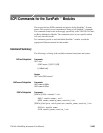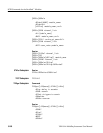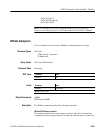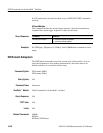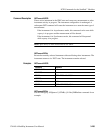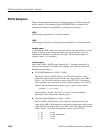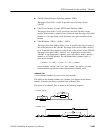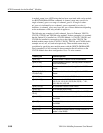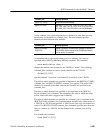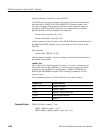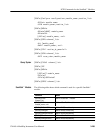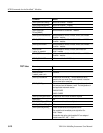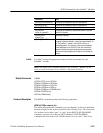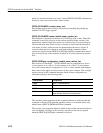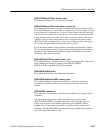
SCPI Commands for the SurePatht Modules
VX4101A MultiPaq Instrument User Manual
3–267
<channel_list> Channels Specified
(@m4(1!1!1:1!16!1)) Same as the previous example
(@m4(1!1!1:2!3!4)) Channels 1!1!1, 1!1!2, 1!1!3, 1!1!4, 1!2!1, 1!2!2, 1!2!3, 1!2!4,
1!3!1, 1!3!2, 1!3!3, 1!3!4, 2!1!1, 2!1!2, 2!1!3, 2!1!4, 2!2!1, 2!2!2,
2!2!3, 2!2!4, 2!3!1, 2!3!2, 2!3!3, 2!3!4 on the VX4380 Module
As the <channel_list> syntax diagram shows, channels on more than one relay
module may be specified in a <channel_list>. The next example specifies
channels on three different relay modules:
<channel_list> Channels Specified
(@m1(1!1), m2(4!6),
m4(3!13!2))
Channel 1 of section 1 on the VX4320, Channel 4 of section 6
of the VX4330, and the channel on the VX4380 that connects
row 3 to column 13 in section 2.
As mentioned above, the module names used in a <channel_list> may be
specified with a [ROUTe:]MODule[:DEFine] command. The command
route:module:Define rfmux, 1
changes the module name assigned to the VX4320 to “rfmux”. The following
<channel_list> can then be used to specify channels on the VX4320.
(@rfmux(3!1,2!2))
specifies channel 3 in section 1 and channel 2 in section 2 of the VX4320.
The order in which channels are specified is important in the [ROUTe:] CLOSE?
<channel_list> and [ROUTe:]OPEN? <channel_list> queries. The states of the
channels are returned in the same order that the channels are specified in the
<channel_list>.
The order in which channels are specified is also important in the [ROUTe:]
SCAN <channel_list> command. This determines the order in which the relays
will be closed each time a trigger event is detected.
The order in which channels are specified in a <channel_list> is important in the
[ROUTe:]CLOSe <channel_list> command when channels in the same section of
a VX4320 or a VX4330 are specified. A VX4320 can close only one channel in a
section. If a [ROUTe:]CLOSE <channel_list> command specifies more than one
relay in a section of a VX4320, the last channel in the <channel_list> will be
closed.
For example, the command
close (@m2(1!1,2!1))



